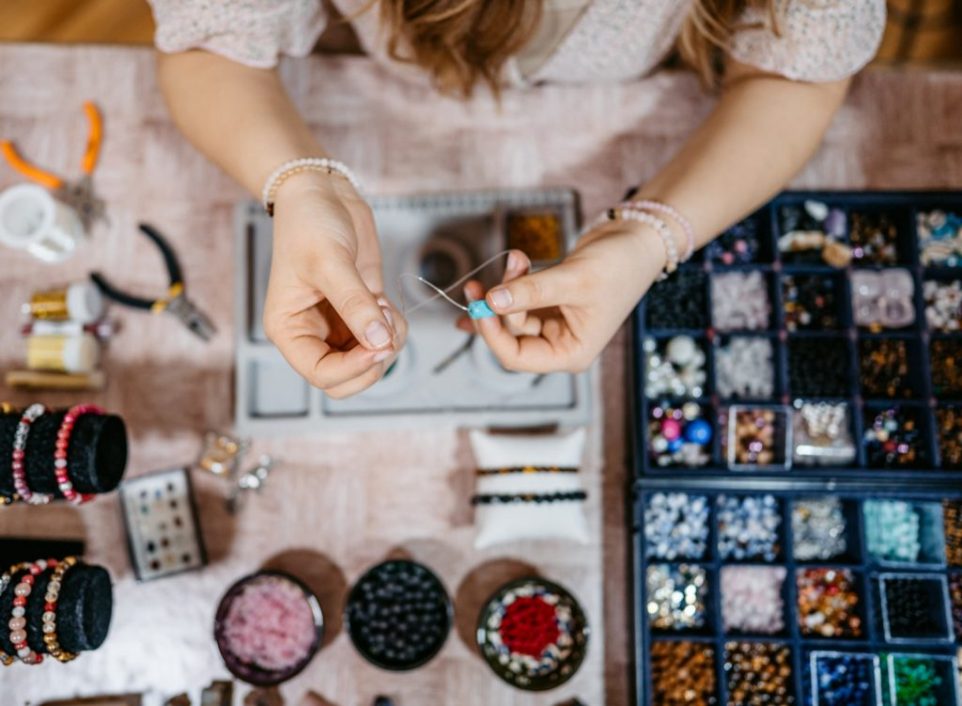Want to Start Silver Smithing in 2024? Here Are All the Jewelry Making Tools You Need

When I first got into jewelry making, I was completely hooked. I loved the idea of creating something beautiful from scratch, but figuring out which tools I needed was another story. I remember spending hours looking at different pliers and cutters, wondering what on earth a mandrel was. So, to save you from that same confusion, I’ve put together a list of must-have tools that will get you started on the right foot. Let’s talk about the essentials you need to kick off your jewelry-making adventure.
Related: How to Make Your Own Jewelry
Pliers for Your Essential Helpers
Pliers are the workhorses of jewelry making, and you’ll need a few different types to get started. Flat nose pliers are great for making sharp bends and holding small pieces. Round nose pliers are perfect for creating loops and curves. Chain nose pliers, with their flat interior and curved exterior, are incredibly versatile for opening and closing jump rings, bending wire, and holding components in place.
Another handy tool is the crimping pliers, which you’ll use for securing crimp beads and finishing off beaded jewelry. It’s worth investing in a couple of good quality pairs because you’ll be using these tools a lot.
Cutters for Clean Cuts Every Time
Good cutters are a must-have for any jewelry maker. Flush cutters are designed to make clean, precise cuts on wire and headpins without leaving sharp edges. They’re essential for trimming excess wire and making neat finishes on your pieces.
Side cutters, on the other hand, are more robust and can handle thicker wires. They’re great for cutting through tough materials without damaging the blades. Make sure your cutters are comfortable to hold and sharp enough to make clean cuts with minimal effort.
Hammers and Mallets for Shaping and Texturing
Hammers and mallets are key tools for shaping and texturing metal. A chasing hammer, with its flat and rounded ends, is versatile for adding texture and for flattening wire and metal sheets. It’s lightweight and easy to control, making it perfect for detailed work.
A rawhide or rubber mallet is another essential tool. It allows you to shape metal without leaving marks or dents. This is particularly useful for forming wire into rings or bracelets on a mandrel. Both types of hammers will serve you well as you begin experimenting with different techniques.
Mandrels and Forms for Getting the Shape Right
Mandrels are crucial for creating consistent shapes. A ring mandrel, marked with sizes, helps you form and size rings accurately. It’s typically made of steel and can withstand the force needed to shape metal.
Bracelet mandrels, which are usually oval or round, are perfect for forming bracelets and bangles. For consistent and professional-looking pieces, mandrels are a must. They come in various shapes and sizes, so as you expand your skills, you might want to invest in a few different types.
Files and Sanding Tools for Smoothing and Finishing
Files and sanding tools are vital for refining your pieces. Hand files come in various shapes, such as flat, half-round, and round, allowing you to smooth edges and refine details. Start with a couple of basic files and expand your collection as you learn more about your needs.
Sanding sticks and wet/dry sandpaper in various grits are also essential. They help you achieve a smooth finish on metal surfaces and prepare them for polishing. These tools are especially useful for removing any rough spots left after cutting or shaping.
Soldering Tools for Joining Metal Pieces
If you plan on working with metal, soldering tools are indispensable. A basic butane torch is a good starting point for soldering small pieces. You’ll also need a soldering block to protect your work surface and reflect heat back onto your piece.
Flux and solder are necessary for the soldering process. Flux cleans and prepares the metal surface, while solder acts as the filler material that joins metal parts together. A solder pick helps you position the solder precisely. Practice is key to mastering soldering, so don’t get discouraged if it feels tricky at first.
Polishing and Buffing Tools for Final Touch
Polishing and buffing tools give your jewelry a professional finish. A rotary tool or a flex shaft with various attachments like polishing wheels, brushes, and buffs can significantly speed up the polishing process. These tools help you achieve a mirror-like shine on metal surfaces.
Polishing compounds, such as tripoli and rouge, are used with buffs to remove fine scratches and bring out the metal’s luster. Start with a basic set and experiment to find the combinations that work best for your projects.
A Good Toolbox for Storage
Keeping your tools and materials organized is crucial. Invest in a good toolbox or storage system to keep everything in its place. This makes it easier to find what you need and protects your tools from damage.
Safety should always be a priority. Safety glasses protect your eyes from flying debris, and a dust mask helps prevent inhalation of fine particles, especially when sanding or polishing. Finger guards or tape can protect your fingers from cuts and burns, making your work more comfortable and safe.
Elevating the Shopping Game
Our platform offers in-depth reviews and analyses across various product categories, empowering you to shop with confidence and precision. Here, transparency and detailed research pave the way for smart choices that reflect your needs and values. Join our community and elevate your shopping experience from buyer to expert, one report at a time.